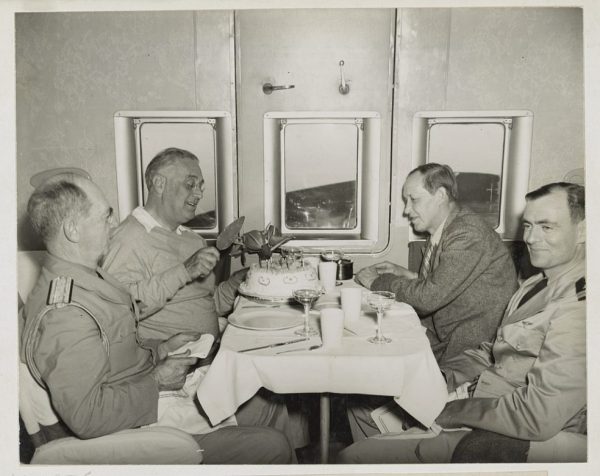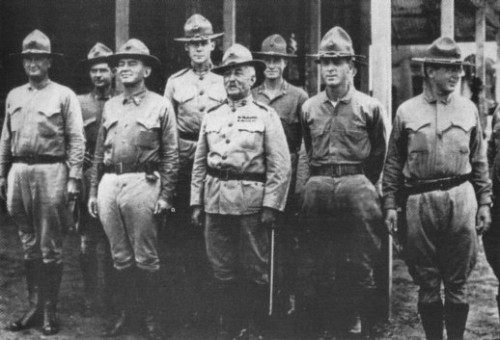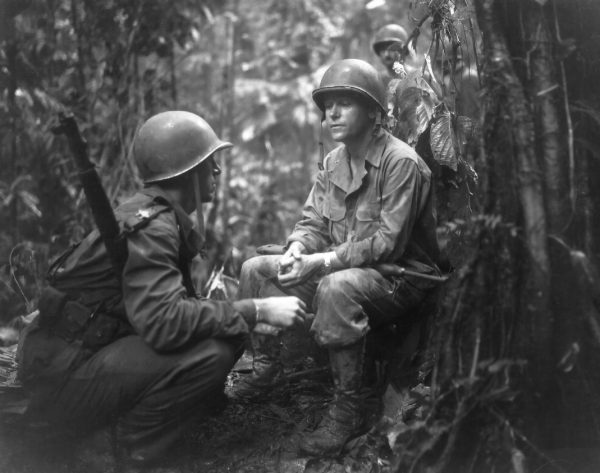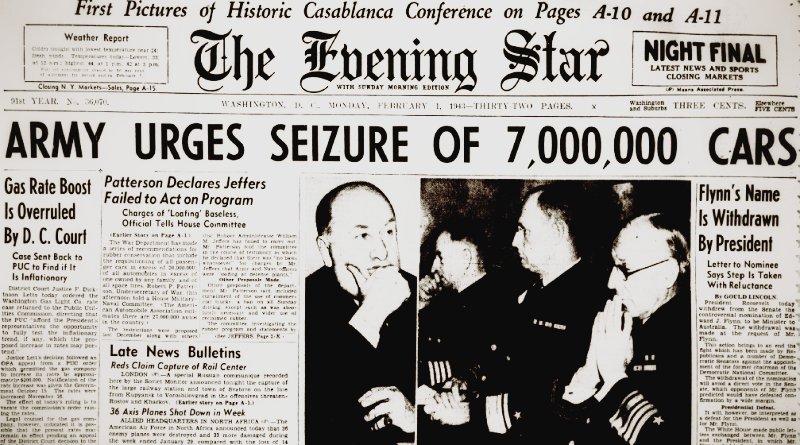World War II Chronicle: February 1, 1943
Click here for TODAY’S NEWSPAPER
The Navy has discharged Owen Ficklin, a 13-year-old boy from Indianapolis, but not until he put in several weeks at Great Lakes Naval Training Center (see page three)… On the same page the German “Tiger” tank has landed in North Africa. It tips the scales at an immense 62 tons — twice as heavy as an M4 Sherman — and features an 88-mm gun…
On January 24 we reported that a Martin Mariner went missing on a trip from Honolulu to San Francisco. Rear Admiral Robert H. English — the commander of the Pacific Fleet’s Submarine Force — was one of the 10 Naval officers on board. The wreckage was discovered yesterday 100 miles to the north in Mendocino County. There were no survivors…
Pictures from the Casablanca Conference are on pages 12 and 13… Pres. Roosevelt became the first sitting U.S. president to fly when he went to Africa. He took the train from Washington to Miami where he boarded a Boeing 314 flying boat named Dixie Clipper. From there it was on to Trinidad, Brazil; and Gambia, where Roosevelt switched to a Transcontinental & Western Air C-54 transport for the last leg of his 7,000-mile journey…

Last November we profiled Maj. Gen. Littleton W.T. Waller, whose son Littleton W.T. Waller Jr. has just been nominated for brigadier general (page 13). Waller Jr. earned the Navy Cross and a Silver Star citation during the battles of Belleau Wood and Soissons, where he was 2nd Division’s machine gun officer. He served as president of the National Rifle Association until 1940.
The elder Waller began his career on the sloop of war USS Lancaster which was commissioned all the way back in 1859. His commanding officer was Capt. Henry Clay Cochrane, who guarded President Abraham Lincoln when he traveled to Gettysburg, Pa. to deliver his famous Gettysburg Address. In 1882 Cochrane accompanied Lieutenant Waller ashore to protect the American consulate during the British bombardment of Alexandria, Egypt.
Waller went pretty much everywhere that Marines were sent during his career, earning the Brevet Medal during the Boxer Rebellion and the Specially Meritorious Service Medal during the Spanish-American War. It’s impressive to note that only 23 men earned the Brevet Medal and less than 100 pinned on a Specially Meritorious Service Medal. As far as we know, Waller is the only man to earn both of these rare awards. Marine legend Smedley Butler not only served under Waller, but was his best man when Waller got married in 1905. Waller recommended Butler for the Medal of Honor (his first) during the Boxer Rebellion…

Speaking of the National Rifle Association presidents, here’s a brief list of those who had served or I find interesting:
- Famous Civil War general Ambrose Burnside was the first NRA president
- Burnside was replaced by NRA co-founder William C. Church, who also founded the Army Navy Journal, which is still in publication and we have linked to previously in the Chronicle. Church was a lieutenant colonel in the U.S. Volunteers during the Civil War
- Alexander Shaler, a Medal of Honor recipient and brevet major general of volunteers, became a New York City fire commissioner after the war
- Henry A. Gildersleeve, a brevet lieutenant colonel and Gettysburg veteran
- Winfield S. Hancock, major general and hero of Gettysburg
- Union officer Edward L. Molineux
- General Ulysses S. Grant
- Maj. Gen. Philip Sheridan, who commanded the Army of the Potomac’s Cavalry Corps
- NRA co-founder George W. Wingate, a captain in the New York National Guard during the Civil War
- Brig. Gen. Bird W.Spencer
- U.S. Senator Smith W. Brookhart, a lieutenant colonel during the Spanish-American War
- Francis E. Warren earned the Medal of Honor as a corporal during the Civil War and rose to the rank of captain. He became a U.S. senator and governor of Wyoming. Francis E. Warren Air Force Base is named in his honor.
- Lewis M. Rumsey Jr. was a captain in the Missouri National Guard and served in the 1st Missouri Volunteer Infantry during the Spanish-American War
- Brig. Gen. Patrick J. Hurley served during the Pancho Villa campaign and fought in World War I. He was Secretary of War during the Herbert Hoover administration and is now a diplomatic officer in the Army
- Benedict Crowell was a brigadier general in the Army Reserve and served as Assistant Secretary of War during World War I
- Ammon B. Critchfield fought in the Spanish-American War and World War I
Sports on page 15… Page 25 has an interesting story of a general (the article claims he was a Marine) who was just attempting to contact a forward unit when he and the men who accompanied him captured three Japanese soldiers and killed three more. You may not know a Maj. Gen. James Collins, but you probably know J. Lawton Collins. When he was given command of the (Army’s) 25th Infantry Division last year, the 46-year-old Collins became the United States’ youngest division commander. Unsure if this was the same incident, but Collins did earn a Silver Star on Jan. 11, 1943 for his role in destroying an enemy machine gun nest under fire.

Roving Reporter by Ernie Pyle
A FORWARD AIRDROME IN FRENCH NORTH AFRICA — The American soldier is a born housewife, I’ve become convinced. I’ll bet there’s not another army in the world that fixes itself a “home away from home” as quickly as ours does.
I’ve seen the little home touches created by our soldiers in their barns and castles and barracks and tents all over America, Ireland, England and Africa. But nowhere has this sort of thing been given such a play as here at this desert airdrome.
The reason is twofold: First the climate here is so dry you can fix up something with a fair certainty that it won’t be washed away in the morning. Second, because of the constant danger of a German bashing, the boys have dug into the ground to make their homes, and the things they can do with a cave are endless, as every farm boy knows.
The basic shelter here is a pup tent, but the soldiers have dug holes and set their tents over these. And the accessories inside provide one of the greatest shows on earth. Wandering among them is better than going to a state fair. The variations are endless.
There are a few fantastically elaborate two-and three-room apartments underground. One officer has dug his deep slit trench right inside his tent, at the foot of his bed. He has even lined the trench with blankets so that he can lie six feet below ground under canvas and sleep during a raid. The finest homes are made by those who are lucky enough to get or borrow the covered-wagon ribs and canvas from a truck. They dig a hole and plant this canopy over the top.
Some of them have these places fixed like sheiks’ palaces. On the dirt floors are mats bought from Arabs in a nearby village. Some have electric lights hooked to batteries. One man bought a two-burner gasoline stove from some Frenchman for $3.20. On it he and his buddies heat water for washing and fry an occasional egg. Furthermore, they have rigged up a shield from a gasoline tin and fitted it over the stove so that it channels the heat sideways and warms the tent at nights.
An officer whose bedroll lies flat on the ground dug a hole two feet deep beside this “bed” so he can let his legs hang over the side normally when he sits on the bed.
Many dugouts have pictures of girls back home hanging on the walls. A few boys have papered their bare walls with Arab straw mats.
One evening I stuck my nose in the dugout of Serg. Ray Aalto, 4732 Oakton Street, Skokie, Ill. He is an ordnance man now, caring for the guns on airplanes, but before the war he was a steam-boiler man.
Aalto has one thing nobody else in camp has. He has built a fireplace inside his dugout. He has tunneled into one end of dugout, and made a double-jointed chimney so that no sparks or light can show. He wishes his wife could see him now.
The deepest and most comfortable dugout I’ve seen was built by four boys in the ground crew of a fighter squadron. It is five feet deep, and on each side they left a ledge wide enough for two bedding rolls, making two double beds. You enter by a long L-shaped trench, with steps leading down from the first part of the L. At the door is a double set of blackout curtains. Inside they have rigged up candles and flashlights with blackout hoods.
Most of the soldiers got o bed an hour or so after dark, because the camp is blacked out and there’s nothing else to do. Only those with blackout lights in their dugouts can stay up and read or play cards or talk.
These four boys have dug a square hole in the wall of their dugout and fitted into it a gasoline tin with a door lock, making a perfect wall safe for cigarets, chocolates, etc. Their dugout is so deep they can stay in it during a raid. In fact they don’t even get out of bed.
It took the four of them three days, working every minute of their spare time, to dig their hole and fix it up. The four are Pvt. Neil Chamblee, of Zebulon, N. C., Pvt. W.T. Minges, Gastonia, N.C., Sergt. Robert Cook, Montpelier, Ind., and Sergt. Richard Hughes, Weiner, Ark.
Sergeant Hughes was especially pleased that I came around, because his mother had written him that I was in Africa and that she hoped our paths would cross, but he never supposed they would.
I believe a character analyst could walk around this camp, and learn more than you could by having the boys fill out a thousand questionnaires. Hundreds of boys have done nothing at all to their tents, but I believe at least half of them have added some home touch. A fellow doesn’t think of these things and work his head off on his own time creating them unless he’s got a real lively ingenuity in him.
Evening star. (Washington, D.C.), 1 February 1943. Chronicling America: Historic American Newspapers. Lib. of Congress.
https://chroniclingamerica.loc.gov/lccn/sn83045462/1943-02-01/ed-1/
